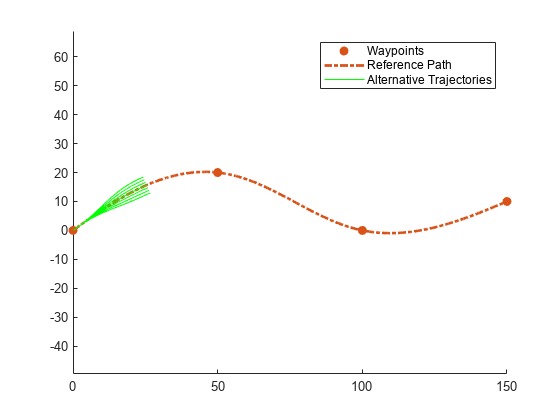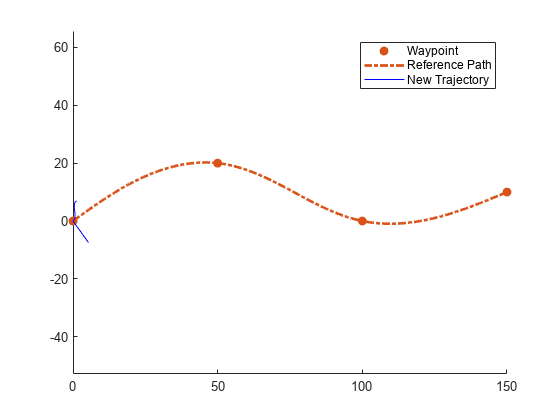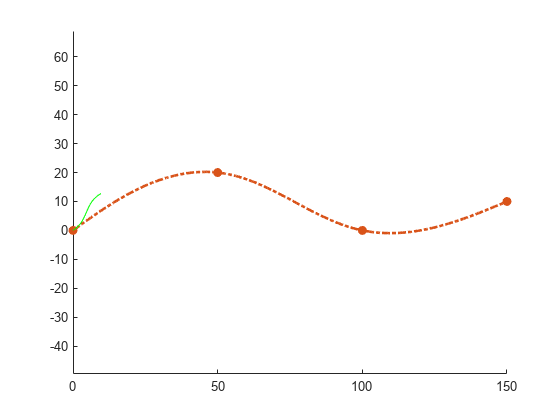referencePathFrenet
웨이포인트에 피팅된 평활한 기준 경로
설명
referencePathFrenet 객체는 [x y] 또는 [x y theta]로 주어진 일련의 웨이포인트에 대해 평활하고 연속적인 조각별 곡선을 피팅합니다. 피팅 후 곡선을 따르는 점, 즉 경로 점은 [x y theta kappa dkappa s]로 표현됩니다. 각 요소는 다음과 같습니다.
x y, theta — 전역 좌표로 표현된 SE(2) 상태(x와 y의 단위는 미터이고 theta의 단위는 라디안임)
kappa — 곡률, 또는 반경의 역수(단위:
m-1)dkappa — 호 길이에 대한 곡률의 도함수(단위:
m-2)s — 호 길이, 또는 경로상에서 경로 원점으로부터의 거리(단위: 미터)
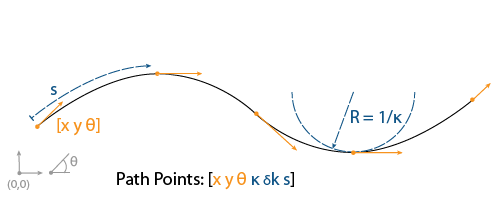
이 객체를 사용하여 전역 좌표계와 Frenet 좌표계 간에 궤적을 변환하고, 호 길이를 기준으로 경로를 따르는 상태를 보간하고, 전역 상태에서 가장 가까운 경로상의 점을 쿼리합니다.
이 객체는 Frenet 상태를 [S dS ddS L dL ddL] 형식의 벡터로 표현합니다. 여기서 S는 호 길이이고 L은 기준 경로 방향으로부터의 직교 편차입니다. S의 도함수는 시간에 대해 상대적입니다. L의 도함수는 호 길이 S에 대해 상대적입니다.
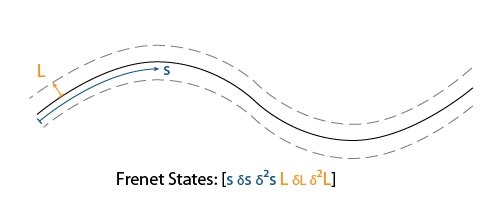
생성
설명
refPathObj = referencePathFrenet(는 지정된 웨이포인트에 대해 일련의 연속적인 조각별 곡선을 피팅합니다. waypoints)waypoints 인수는 Waypoints 속성을 설정합니다.
refPathObj = referencePathFrenet(___,는 위에 열거된 구문의 입력 인수 외에 하나 이상의 이름-값 입력 쌍 인수를 사용하여 속성을 설정합니다. DiscretizationDistance 속성과 MaxNumWaypoints 속성을 이름-값 인수로 지정할 수 있습니다.Name,Value)
속성
객체 함수
closestPoint | Find closest point on reference path to global point |
closestPointsToSequence | Projects sequence of points onto path |
closestProjections | Find orthogonal projections between path tangent vector and query point |
curvature | 호 길이에서 곡률 반환 |
changeInCurvature | 호 길이에서 곡률 변화 반환 |
frenet2global | Convert Frenet states to global states |
global2frenet | Convert global states to Frenet states |
interpolate | Interpolate reference path at provided arc lengths |
position | 호 길이에서 xy 위치 반환 |
tangentAngle | 호 길이에서 탄젠트 각도 반환 |
show | Display reference path in figure |
copy | Copy reference path |
예제
세부 정보
참고 문헌
[1] Werling, Moritz, Julius Ziegler, Sören Kammel, and Sebastian Thrun. "Optimal Trajectory Generation for Dynamic Street Scenarios in a Frenet Frame." 2010 IEEE International Conference on Robotics and Automation. 2010, pp. 987–993.
[2] Bertolazzi, Enrico, and Marco Frego. “Fast and Accurate Clothoid Fitting.” Mathematical Methods in the Applied Sciences 38, no. 5 (March 30, 2015): 881–97. https://doi.org/10.1002/mma.3114.
확장 기능
버전 내역
R2020b에 개발됨

